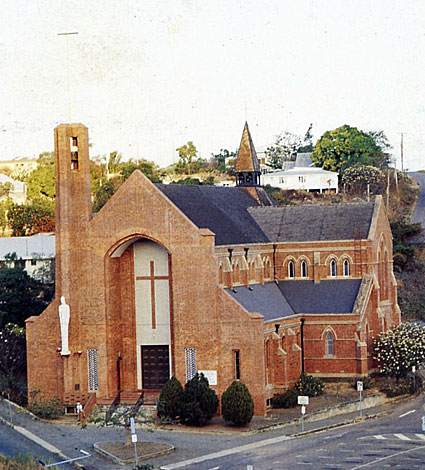
St James' Anglican Cathedral, Townsville
[Photograph from A Tour of St James' Cathedral
Townsville, North Queensland (c.1980s)]

St James' Anglican Cathedral, Townsville
[Photograph from A Tour of St James' Cathedral
Townsville, North Queensland (c.1980s)]
Historical and Technical Documentation by Geoffrey Cox1
© OHTA 2011, 2013, 2015, 2020 (last updated September 2020))
Townsville was established in the early 1860s, and developed initially as a port for the grazing industry that had become established in the hinterland. The town was first called 'Cleveland Bay' and later 'Castletown'. It was named Townsville in 1866 after Captain Robert Towns, a Sydney mariner and businessman who held pastoral leases in the area. The discovery of gold and copper in the region, especially at Charters Towers, gave impetus to its growth from the 1870s onwards. Townsville was declared a city in 1903, and is now the commercial, industrial and cultural hub of northern Queensland.
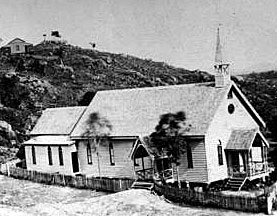
St James' Church of England in Townsville, c.1875
[Photograph: John Oxley Library, State Library of Queensland]
The first St James' Church in Townsville, a weatherboard structure with shingle roof, was built on this site in 1871. Following the creation of the Anglican Diocese of North Queensland in 1878, it became the Cathedral. Plans for a new cathedral were drawn up in 1885 by the Sydney firm of architects Blacket Bros (Cyril and Arthur Blacket). With Cyril Blacket's retirement that year, however, the work was carried out entirely by Arthur Blacket. The foundation stone was laid in June 1887, and the building was dedicated in October 1892. Repairs were carried out following damage by cyclone 'Leonta' in March 1903, but the building remained incomplete until the late 1950s. The final extension of the nave, designed by Melbourne architect Louis Williams, was completed in 1960.2
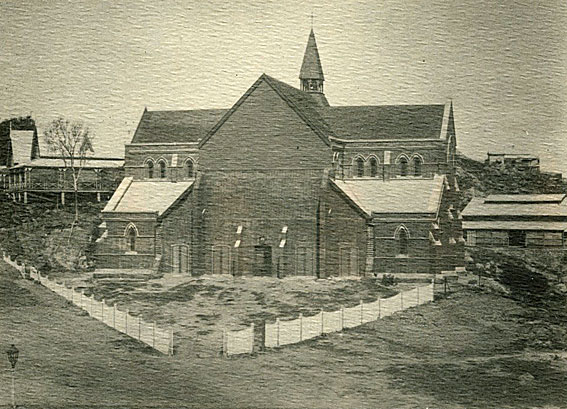
The incomplete cathedral as it existed between 1892 and the late 1950s
[Photograph from 'A Portfolio of Drawings Photographs and Notes
on the Occasion of the Consecration of the Cathedral, 24 June 1978', supplied by Stephen Baldwin]
The organ was installed in 1885 in the old church, having been built by Brindley & Foster of Sheffield. It was the first pipe organ installed in North Queensland, and the only example in Queensland of the work of Brindley & Foster. Other examples of their work are to be found in New South Wales and Tasmania. The earliest was the Brindley & Co. instrument of 1860 now at the Albert Hall, Launceston, but it was in the 1880s that the firm exported most instruments to Australia. Only two of these have survived intact: at St John-the-Baptist Anglican Church, Mudgee, NSW (1881, 3 manuals, 24 stops) and at St Peter's Anglican Church, St Peter's, NSW (1880, 2 manuals, 12 stops).3
The Townsville instrument was the gift to the Diocese of North Queensland by Miss M.E. Holland at Christmas 1884.4 It arrived in April 1885, and was erected at the west end of the old church by Mr T.C. Christmas of Brisbane.5 At the opening and dedication, which took place on Wednesday 22 April, 'Professor Benson' played the organ, and the Bishop of Ballarat [Bishop Thornton] presided.6
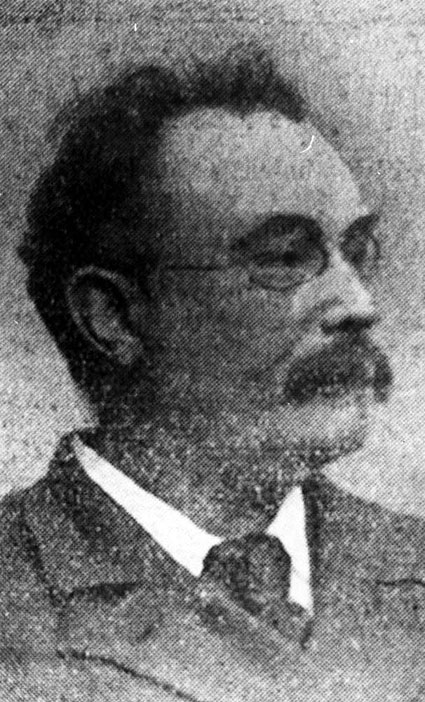
Samuel George Benson (1849-1925)
[Photograph: John Oxley Library, State Library of Queensland]
Samuel George Benson appears to have moved to Australia in order to take up the organist post in Townsville, though he did not stay there long. According to a newspaper report of 1906, he moved to Charters Towers for a period, and then to Brisbane:
Mr S. G. Benson is a Londoner, . . . on coming to Townsville, he became organist at St. James's Cathedral, where he opened the first pipe organ in North Queensland. After other good work, including a period at Charters Towers, Mr. Benson came to Brisbane. He was then appointed organist of the Fortitude Valley Wesleyan Church, . . . [later] at St Paul's Presbyterian Church . . . [and] for ten years organist and choirmaster at the Albert-street Wesleyan Church . . . He was one of the musical directors of the International Exhibition in 1897, and gave daily recitals on the grand organ.7
The earliest record of the specification of the organ for St James' is one published in The Musical Standard in January 1885 at the time the instrument was shipped from England. It was listed as having been built by Messrs Brindley & Foster of Sheffield for 'Townsville Cathedral Church':
1. 2. 3. 4. 5. 6. 7. 8. 9. 10. |
GREAT ORGAN. Open Diapason Gedact Dulciana Harmonic Flute SWELL ORGAN. Violin Diapason Lieblich Gedact Vox Angelica Salicet Oboe PEDAL ORGAN. Bourdon COUPLERS Swell to Great Swell to Pedal Great to Pedal |
CC to A 8 8 8 4 CC to A 8 8 8 4 8 CCC to F 16 |
Two composition pedals.8
Charles Brindley trained with the German organ builder Edmund Schulze, and went into partnership with A. Healey Foster around 1870. Brindley's tonal style in the flue stops and diapason chorus is said to have been indebted to the influence of Schulze, while the characteristic bright chorus reeds and the beauty of the firm's imitative orchestral reeds are normally attributed to Foster.9 Most Brindley & Foster organs up to the 1890s used mechanical action, but as early as 1884 they had developed their own tubular-pneumatic actions.10
The Townsville organ was transferred in 1892 from the old church to the new cathedral, where it was located in the ambulatory. It presumably suffered considerable damage when cyclone 'Leonta' unroofed the building in March 1903.
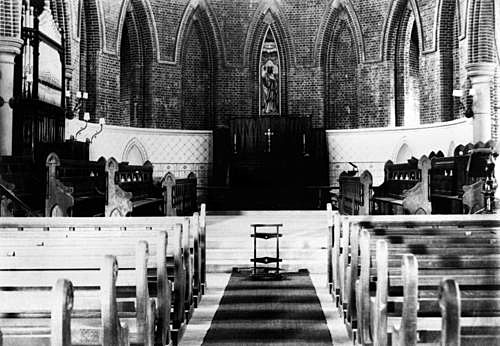
The interior of St James' Cathedral in Townsville, c.1902
with the 1884 Brindley & Foster organ installed in the ambulatory
[Photograph: John Oxley Library, State Library of Queensland]
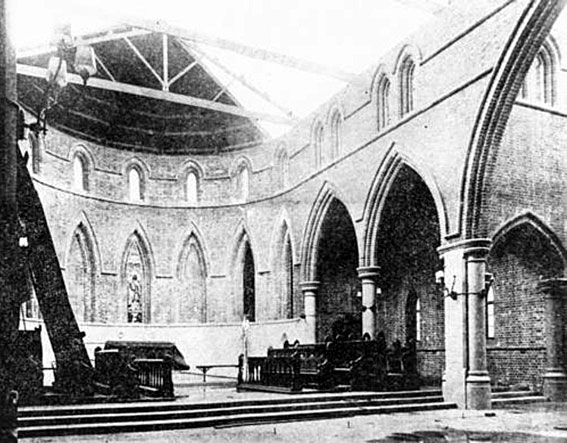
St James' Cathedral unroofed following cyclone 'Leonta' in March 1903
[Photograph: John Oxley Library, State Library of Queensland]
It was shortly after this catastrophe that the cathedral chapter wrote to the original organbuilders, Messrs Brindley & Foster. Two letters survive: The first, dated July 1903, suggests additions to the organ as proposed by the cathedral organist (who is not named in the correspondence).11 The second letter, dated November 1903, reveals that Brindley & Foster had proposed instead the complete replacement of the old organ, whereas the cathedral authorities preferred to enlarge the existing instrument.12
The latter option obviously prevailed: The cathedral's souvenir booklet (c.1960) stated that there were 'two organs coupled together . . . in the ambulatory behind the lay canons' stalls . . . rebuilt as one organ' in 1958.13 Evidence for 'two organs' is also to be found in a specification of the organ recorded before 1958 by the late Mr Percy Brier of Brisbane. Brier differentiated between the 'OLD ORGAN (in use)' as above, and the 'NEW ORGAN (not in use)' as follows:
| GREAT Large Open Diapason [Principal] Twelfth Fifteenth Trumpet SWELL Double Diapason Voix Celestes Twelfth Fifteenth Cornopean Clarion PEDAL Open Diapason Bass Flute COUPLERS Swell Sub Octave Swell Super Octave Pedal Octave.14 |
8 [4] 2-2/3 2 8 16 8 2-2/3 2 8 4 16 8 1 |
It is clear from these details that the so-called 'new organ' was not in fact a separate instrument, but constituted substantial additions to the original instrument, more than doubling its size. The presence of several octave couplers among the additions suggests that the new part of the organ used tubular-pneumatic action. This is borne out by details in the photograph below, which is tentatively dated 1906:
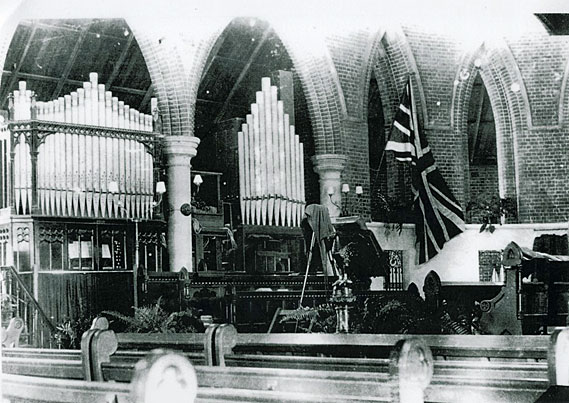
The new section of the organ being installed, c.1906, showing the
pneumatic tubing to the soundboard, the pneumatic-action swell box
and wooden pipes of the new Open Diapason 16ft
[Photograph courtesy of Mrs Sally Maddox, supplied by Tom Gray]
The details of the 'new organ' recorded by Percy Brier agree exactly with those proposed in the correspondence of 1903 from the cathedral chapter to Brindley & Foster. This, together with the consistent markings on all of the old and new pipework (as shown in the specification below) confirms that the additions were supplied by Brindley & Foster.
The enlargement of the organ in this manner obviously involved some degree of compromise, and it is significant that only the 'old organ' was operating by the time Brier visited it. Mr Eric Field, the cathedral organist between 1952 and 1966, reported that there was a noticeable difference in response between the stops of the old and new organs, and that the pneumatic part of the organ did not work well, if at all, by the 1950s.15
The photographs below show the original organ on the left, and the new section on the right without a console. The console on the original organ by this time clearly included all the stops for both the old and new parts of the instrument.
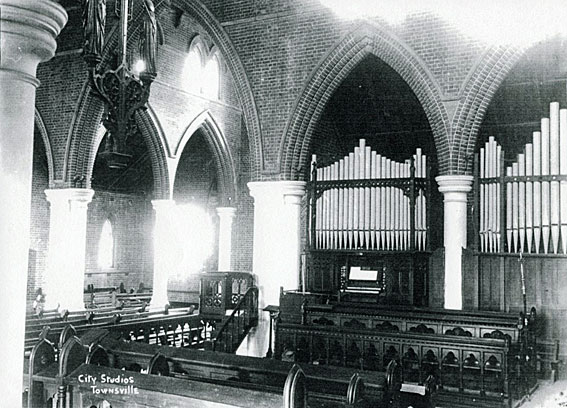
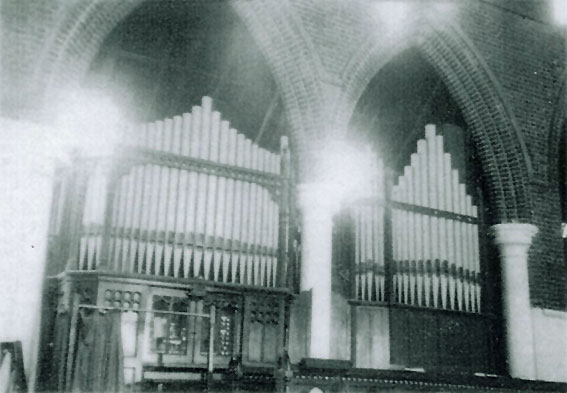
The two sections of the Brindley & Foster organ, c.1920s
[Photographs from the cathedral archives, supplied by Tom Gray]
The organ was rebuilt in 1958 by Noel Ferguson, an optometrist of Cairns, and placed in a new organ loft above the Warrior's Chapel. No new stops were added at this time, although there was preparation for enlargement. Ferguson electrified the action, making new sliderless electro-pneumatic chests, and provided a new detached stop-key console. All that remained of the old organ, therefore, was the Brindley & Foster pipework and a set of double-rise bellows. Ferguson did not re-use the Swell Double Diapason, although the pipes for this stop (of mahogany and marked 'SW.BOURD') were stored at the cathedral. The compass of the manuals remained at 58 notes and the pedals at 30 notes, as in the original organ. Two additional couplers (Swell Octave to Great and Swell Sub Octave to Great) were provided by Ferguson, and the Pedal Octave coupler was deleted. Accessories included a Swell tremulant, and 4 thumb pistons to each of the manuals, and 2 toe pistons to the pedals.16

The organ as rebuilt by Noel Ferguson in 1958
[Photograph by Stephen Baldwin (1987)]
In December 1971, cyclone 'Althea' caused considerable damage to the organ, and Messrs Whitehouse Bros of Brisbane were called in to make repairs. The position of the console continued to be problematic, located as it was behind the lay canons' stalls at some distance from the organ.17 Furthermore, the wind pressures, as evidenced in 1974, did not allow the pipework to speak with anything like the expected sound of a Brindley & Foster organ.18 The cause of this has since been identified by Ian Brown as the inadequate size of the valves and holes in the 1958 cone-valve windchests, and also by the likelihood that the 1884 and c.1906 pipework was intended to speak on different wind pressures.19
By the early 1980s the condition of the instrument had seriously deteriorated, and proposals were developed to rebuild or replace it. There was agreement at the time that a new West gallery should be built for the purpose, and the English firm of J.W. Walker & Sons submitted proposals for a completely new mechanical-action instrument.20 Cost factors undoubtedly prevailed, and the decision was eventually made to re-build and enlarge the instrument in its existing position.
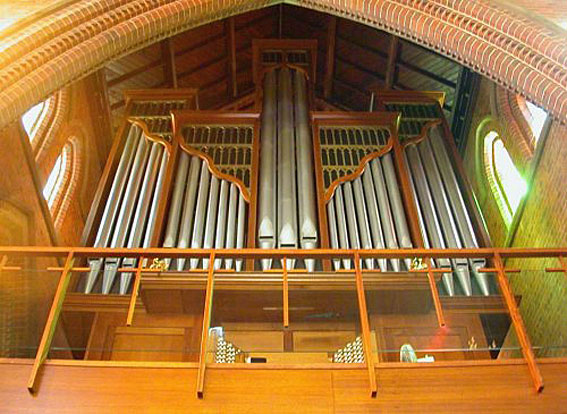
The organ as rebuilt and enlarged by Brown & Arkley of Sydney in 1992
[Photograph by Eleanor Skilton (2002)]
In 1991-92, the existing gallery was enlarged and the organ was rebuilt and enlarged by Brown & Arkley of Sydney at a total cost of around $350,000.21 It was re-opened in June 1992 with a recital by Christopher Cook. New slider soundboards were supplied, together with new casework of Nyatoh and Coachwood, and a new four-manual console of American White Oak.22 All of the Brindley & Foster pipework was retained, largely in its original configuration, along with the surviving double-rise bellows. The new Choir division (unenclosed) was conceived as the second division of the organ, and is placed in front of the Great, immediately behind the façade pipes. The casework ensures that the sound is projected through the arch and into the body of the cathedral.23
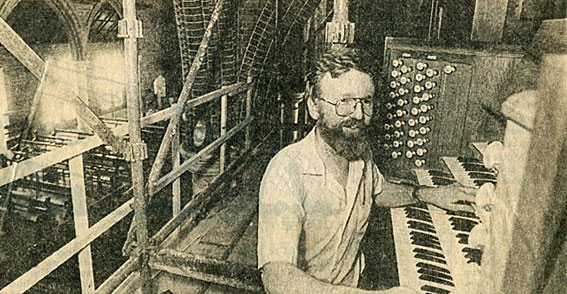
Ian Brown installing the rebuilt organ in 1992
[Photograph from Townsville Bulletin (14 March 1992)]

[Photograph by Stephen Baldwin (2008)]
A 32ft (polyphone) bass octave was added in 1999 to replace the former 'acoustic bass' arrangement. Supplied by Ian D. Brown and Associates of Ballina, it had been manufactured by Steve Laurie of Melbourne and modelled on the 'John Compton 32ft Bass Cube.' The cube contains three large Bourdon pipes, each capable of sounding two different pitches, thus producing the six notes F#-B.24
To mark the tenth anniversary of the rebuilt instrument, a new Hohl Flute 8ft stop was added to the Solo division by Ian D. Brown & Associates in 2002. The latter was dedicated to the memory of Frank Carroll, who was organist of the cathedral from 1966 to 1994. A tremulant was added to the Choir Organ at the same time, and further adjustment was made to wind pressures and voicing.25

The four-manual console supplied by Brown & Arkley of Sydney in 1992
[Photograph by Howard Baker (1990s)]
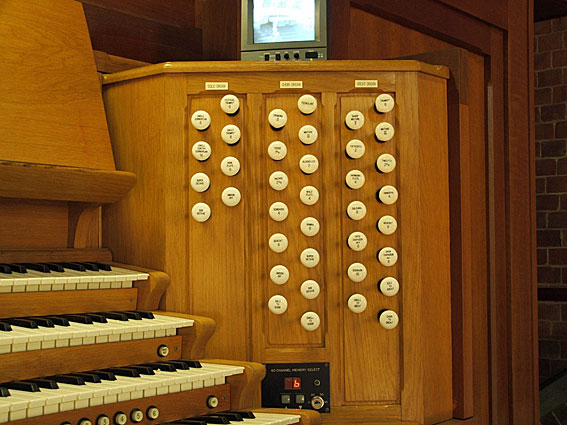
The right-hand stop jamb on the 1992 console
[Photograph by Stephen Baldwin (2008)]
The history of this instrument shows that it has survived against considerable odds. It has been battered by cyclones in 1903 and 1971, enlarged in a compromised manner around 1906 with pipework on two different actions and two different wind pressures, and then rebuilt in 1958 by an amateur organbuilder who discarded all of the Brindley and Foster material apart from the pipework and one large double-rise bellows. The work of bringing it together in 1992, with further adjustment of voicing and wind pressures in 2002 has necessarily taken account of this chequered history.
| GREAT ORGAN Bourdon Open Diapason No 1 Open Diapason No 2 Gedeckt Dulciana Principal Harmonic Flute Twelfth Fifteenth Mixture Sharp Mixture Trumpet |
16 8 8 8 8 4 4 2-2/3 2 III II 8 |
A B |
[c.1906 on Swell] [c.1906] [1884] [1884] [1884] [c.1906] [1884] [c.1906] [c.1906] [c.1906] |
Pipe markings SW.BOURD OPEN OPEN R.GDT DUL PRIN HAR.FL 12TH 15TH TP |
| SWELL ORGAN Violin Diapason Gedeckt Salicional Voix Celestes [Ten.C] Principal Flute Twelfth Fifteenth Mixture Contra Cornopean Cornopean Oboe Clarion |
8 8 8 8 4 4 2-2/3 2 III 16 8 8 4 |
C C |
[1884] [1884 'Lieblich Gedact'] [1884 'Vox Angelica'] [c.1906] [1884 'Salicet'] [c.1906] [c.1906] [c.1906] [1884] [c.1906] |
SW.VIOL SW.GED SW.VOX SW.VIOX SW.SAL SW.12TH SW.15TH HN [not marked] CLAR |
| CHOIR Gedeckt 8 Gamba Gemshorn Wald Flute Nazard Blockflute Tierce Mixture Cremona |
8 8 4 4 2-2/3 2 1-3/5 III 8 |
|||
| SOLO Hohl Flute 8 Swell Contra Cornopean Swell Cornopean Great Trumpet Festival Trumpet |
8 16 8 8 8 |
C C B |
[2002] |
|
| PEDAL Contra Bourdon Major Bass Open Diapason Bourdon Echo Bourdon Principal Bass Flute Fifteenth Flute Mixture Contra Trombone Trombone Contra Cornopean Trumpet |
32 16 16 16 16 8 8 4 4 III 32 16 16 8 |
D A D D A E E C E |
[polyphone bass, 1999] [c.1906 'Open Diapason'] [1884] [c.1906] [bottom octave electronic] |
PED.OPEN PED.BOURD PED.FLUTE |
| COUPLERS Swell to Pedal Great to Pedal Choir to Pedal Solo to Pedal Swell to Great Choir to Great Solo to Great Swell Super Octave Swell Sub Octave Swell Unison Off Solo to Swell Choir Super Octave Choir Sub Octave Choir Unison Off Solo to Choir Swell to Choir Solo Super Octave Solo Sub Octave Solo Unison Off |
||||
| Swell tremulant Choir tremulant Solid state switching Micro-processor capture system Compass: 61/32 Electro-pneumatic action.26 |
[2002] |
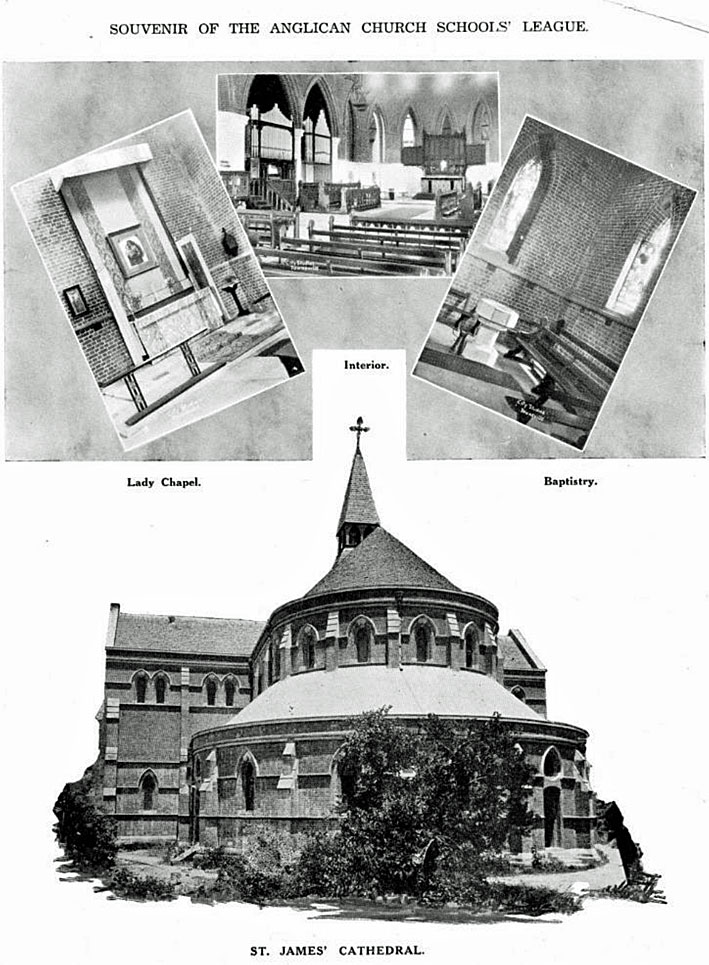
from: Anglican Church Schools' League, Diocese of North Queensland: Souvenir (Townsville: Willmet & Sons, 1933), p. 79.
[supplied by Stephen Baldwin (September 2020)]
______________________________________________________________________________
1 An earlier version of the historical documentation presented here appeared in 1992 as: Geoffrey Cox, 'A History of the Organ at St James' Anglican Cathedral, Townsville,' The Organ Voice, vol. 19, no. 5 (April 1992), pp. 33-38.
2 [Souvenir Booklet] North Queensland's Cathedral (Townsville, c.1960); Donald Watson & Judith McKay, Queensland Architects of the 19th Century: A Biographical Dictionary (Brisbane: Queensland Museum, 1994), p. 19.
3 Graeme Rushworth, Historic Organs of New South Wales (Sydney: Hale & Iremonger, 1988), p. 225.
4 Plaque cited by Geoffrey Cox, July 1974.
5 Diocese of North Queensland, 'Diocesan Diary for 1885,' pp. 7-8 (7 April, 1885).
6 Diocese of North Queensland, 'Diocesan Diary for 1885,' p. 9 (22 April, 1885); Diocese of North Queensland, The Monthly Record of Church Work (25 April, 1885), p. 8; 'Diary of Events' for 23 April, 1885 in Pugh's Queensland Almanac for 1886.
7 The Daily Mail (Brisbane, 10 March 1906), p. 9.
8 The Musical Standard, vol. 28, no. 1069 (24 January 1885), p. 58.
9 J.R. Knott, 'Brindley & Foster - Organbuilders of Sheffield,' OHTA News, vol. 2, no. 3 (July 1978), pp. 17-32.
10 Rushworth, op. cit.
11 Letter from John O'Callaghan (secretary, St James' Cathedral Chapter) to Messrs Brindley & Foster, 22 July 1903, supplied to G. Cox by Michael Fellows (co-ordinator of the 1992 rebuilding project, and co-director of music & organist from 1995), 13 April 1992.
12 Letter from John O'Callaghan (secretary, St James' Cathedral Chapter) to Messrs Brindley & Foster, 3 November 1903, supplied to G. Cox by Michael Fellows, 13 April 1992.
13 Souvenir Booklet, op. cit.
14 Specifications of the late Mr Percy Brier, supplied to G. Cox by R.K. Boughen, c.1973.
15 Personal communications to Tom Gray from Eric Field and others, 1970s.
16 Details noted by John Maidment and Geoffrey Cox, July 1974, and by Robert Wallace, Feb 1961 & July 1967.
17 Eric Field, 'The Cathedral Organ,' in Centenary Book The Diocese of North Queensland 1878-1978 (Townsville: Diocese of North Queensland, 1978), p. 60, cited by Stephen Baldwin (co-director of music, 1995-2003, and choir director, 2005-08), October 2011.
18 Organ inspected by John Maidment and Geoffrey Cox, July 1974.
19 Ian Brown, 'St James' Cathedral Organ: An Organ Builder Looks Back Nearly Twenty-Five Years,' The Organ Voice, vol. 32, no. 2 (June 2005), pp. 6-16; also in The Sydney Organ Journal, vol. 36, no. 4 (Spring 2005), pp. 53-56.
20 'Annual Report of the Organ Committee for 1982' (7 February 1983), from the papers of Frank Carroll, cited by Stephen Baldwin, October 2011.
21 Townsville Bulletin (14 March 1992).
22 The Organ Voice, vol. 19, no. 3 (December 1991), p. 54; Townsville Bulletin (14 March 1992); Brown, op. cit.
23 Brown, op. cit.
24 The Organ Voice, vol. 25, no. 2 (June 1999), p. 21; Brown, op. cit, p. 11; Vox (October 1989), p. 12.
25 Brown, op. cit., pp. 13-14; The Sydney Organ Journal, vol. 33, no. 4 (Spring 2002), pp. 46-47.
26 Specification from Organ Society of Queensland Newsletter, vol. 19, no. 1 (August 1991), p. 25; further details supplied by Michael Fellows, April 1992, and more recent sources cited above. Pipe markings noted by John Maidment and Geoffrey Cox, July 1974.